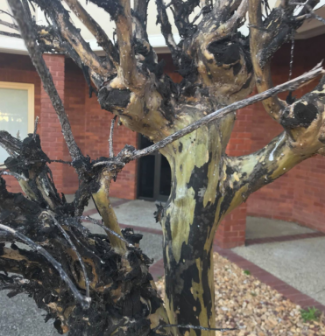Contact
Randy Forst
Extension Educator - Consumer Horticulture
Phone: (501) 671-2245
Email: rforst@uada.edu
Crapemyrtle Bark Scale - What is this white stuff on my crapemyrtle trees?
Since the initial sighting in 2004, the crapemyrtle bark scale (CMBS) insect has been spreading at an alarming rate across the Southeast. The insect was first noted in McKinney, Texas (self-designated as America’s “crapemyrtle city”), in 2005 and had spread throughout most of the Dallas-Fort Worth area by 2010. The scale was reported in Ardmore, Okla., and Shreveport, La., in 2012 and Houma, La. (60 miles southwest of New Orleans) in 2013.
How can I identify crapemyrtle bark scale?

If left undetected or untreated, the CMBS will spread rapidly. A heavy infestation will result in white crusted clusters of insects which may blanket small stems and be quite visible on the trunks. If you get up close or use a magnifying glass, you will see that the adult is white to gray in color and there may be dozens of pink eggs or crawlers under some of the larger white scale covers. It is suspected that there may be at least two generations in Arkansas.
Sooty mold appearance - what is it?
Most gardeners will be alerted to CMBS by black sooty mold which appears on the bark . The presence of sooty mold may confuse the diagnosis since that is also commonly associated with a significant aphid problem. This sooty mold grows on a by-product of sucking insects including scale and aphids. As these insects feed, they give off a sweet substance called honeydew. Wherever this honeydew lands, the stems, leaves and trunk get very sticky and then a black sooty mold will form. If that sooty mold is accompanied with white specks on the trunks or branches, that is the crape myrtle bark scale, and is cause for action.
Still not sure if you have scale?
Send our experts a photo and ask for their advice.
Will crapemyrtle bark scale kill my trees?
No need to remove your trees if you suspect infestation. However, treatment is necessary. The scale will NOT kill your trees but they reduce the amount and size of the blooms and the sooty mold makes them less attractive.
How do I treat for crapemyrtle bark scale?
Systemic insecticides work very well to control the bark scale, but the timing is most effective when applied in late winter/early spring.
- If you are just now spotting the problem, you can clean off the trunk with warm, soapy water to remove the black sooty mold.
- Once all the leaves have fallen, saturate the tree with a dormant oil. This should kill many of the crawlers and adults, but won’t kill them all.
- Then treat with a systemic insecticide in late March through early May with a product containing Imidacloprid (Merit® or Bayer Advanced™ Tree and Shrub
Insect Control), or thiomethoxam (Meridian® ) or dinotefuran (Greenlight Tree and
Shrub Insect Control with Safari). These products will be taken up by the tree and
moved throughout the system of the tree, and have shown good results in controlling
the scale.
 If you are just now spotting black sooty mold on your crape myrtle trees you can clean off the trunk with warm, soapy water to remove the black sooty mold.
If you are just now spotting black sooty mold on your crape myrtle trees you can clean off the trunk with warm, soapy water to remove the black sooty mold.
How can I keep scale from spreading?
If you have small limbs which are heavily infested prune them off and dispose of them. Do not put them in a compost pile, or put them out on the curb for yard-waste pick-up. In a perfect world, burning the debris would be the best way to eradicate the pest, but unfortunately we can’t burn refuse in the city.
Left exposed in an open truck or put on the curb for yard waste pickup leads to a possibility that the millions of tiny crawlers could be easily spread to neighboring properties, thus accelerating the spread of this invasive insect. Instead, double bag the cuttings and put them in your regular trash pickup
Be aware, once the insects die, they will still be on the plant, but no longer causing damage and not spreading. There is no need to do preventative treatment, so only treat a tree that has the insect problem—but do monitor all the crape myrtles in your yard. The sooner you can catch the problem, the easier and quicker the problem can be solved.
Report infestations of crapemyrtle bark scale
Is your county included in infestations? Look at this map to find your county and please take a picture of the tree with symptoms and/or a sample in to your local county extension office.